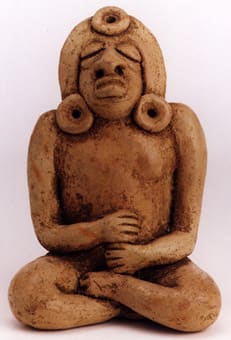Mayan Sculpture of a Seated Man, 6th Century CE - 9th Century CE
Terracotta
7.5
PF.3555
The summit of the classical age in Ancient Meso-America was reached by the Maya in their great temple cities. In those temple cities, great artistic expressions such as murals and...
The summit of the classical age in Ancient Meso-America was reached by the Maya in their great temple cities. In those temple cities, great artistic expressions such as murals and sculptures flourished. It is during this classical period in which artists refined their skills to represent the human forms, deities, and other symbolic art works. Used in various rituals and ceremonies, their art embodied rich symbolism, laden with complex meanings, which largely remain esoteric. A fine example of the magnificent Mayan sculpture, this terra-cotta figure sits with his hands on his belly and his legs crossed. Such distinct position seems to suggest that perhaps the pose has a certain significance. It is a serene and restful position, which creates a feeling of meditative self-absorption and containment. With its head slightly raised, the face displays the distinct Mayan features--heavy lidded eyes, large, hooked nose, and fleshy lips. The figure also wears large ear-flares and a headdress. Decorated with such attire denoting the status of the figure, this sculpture most likely represents an image of a dignitary or a priest. Or perhaps it is a depiction of a wise elder, or an ancestor. As many Mayan art was used in rituals and ceremonies, this beautiful sculpture may have had been an important ritual offering, depicting an image of a dignified person. As we look into the artwork, we are reminded of an ancient culture and its images that flourished hundreds of years ago.
